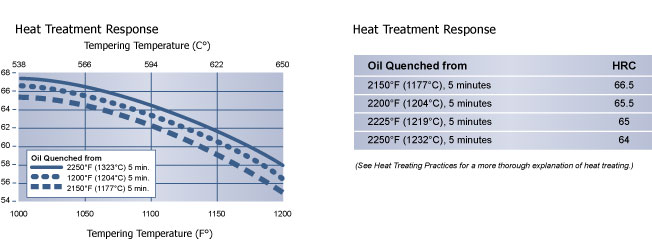CPM Rex T15 Powder Metal High Speed Steel
CPM Rex T15 powder metallurgy high-speed steel is cobalt-bearing super high-speed steel which can be heat treated to a hardness as high as 67 Rockwell C. A high volume of hard vanadium carbides provides very high wear resistance. The cobalt content provides excellent resistance to softening at high service temperatures (red or hot hardness). These properties translate into extended retention of hard, sharp cutting edges on tools produced from CPM Rex T15. Because of the powder metal (PM) manufacturing, CPM Rex T15 is far easier to grind and exhibits impact toughness that is more than double that of traditional, ingot-cast T15 high-speed steel.
APPLICATIONS: Typical tooling applications in which CPM Rex T15 excels include high-performance broaches, form tools, milling cutters, end mills, taps, and reamers. CPM Rex T15 is the high-speed steel of choice for any cutting application on strong or abrasive materials that generate high cutting tool temperatures.
Composition
| C | Mn | Si | Cr | W | Mo | V | Co |
| 1.60 | 0.30 | 0.30 | 4.00 | 12.00 | 0.75 | 4.90 | 5.00 |
Relative Properties


Physical Properties
- Density: 0.296 lb/in3 (8193 kg/m3)
- Specific Gravity: 8.19
- Modulus of Elasticity: 30 x 106 psi (207 GPa)
- Machinability: 35-40% of a 1% carbon steel

Heat Treating Instructions
| Critical Temperature: | |
| Ac1: 1520°F (827°C) | Ac3: 1570°F (854°C) |
| Ar1: 1445°F (785°C) | Ar3: 1410°F (766°C) |
Hardening
Preheating: 1500-1550°F (816-845°C), equalize. A second preheat at 1850-1900°F (1010-1040°C) is recommended for vacuum hardening.
Austenitizing (High Heat): Heat rapidly from the preheat.
Furnace: 2150-2260°F (1177-1238°C)
Salt Bath: 2150-2250°F (1177-1221°C)
The use of a lower austenitizing temperature will maximize impact toughness. The use of a higher austenitizing temperature will maximize hot hardness and wear resistance.
Quenching: Pressurized gas, warm oil, or salt.
For pressurized gas, the furnace should have a minimum quench pressure of 4 bars. A quench rate of approximately 400°F (222°C) per minute to below 1000°F (538°C) is critical to obtain the desired properties.
For oil, quench until black, about 900°F (482°C), then cool in still air to 150-125°F (66-51°C), equalize in the salt, then cool in still air to 150-125°F (66-51°C).
Tempering: Temper immediately after quenching. Typical temperature range is 1000-1100°F (538-593°C). Do not temper below 1000°F (538°C). Hold at temperature for 2 hours then air cool to ambient temperature. Triple tempering is required.
Annealing
Annealing must be performed after hot working and before rehardening.
Heat at a rate not exceeding 400°F per hour (222°C per hour) to 1575-1600°F (857-871°C), and hold at temperature for 1 hour per inch (25.4 mm) of maximum thickness; 2 hours minimum. Then cool slowly with the furnace at a rate not exceeding 30°F per hour (15°C per hour) to 1000°F (538°C). Continue cooling to ambient temperature in the furnace or in air. The resultant hardness should be a maximum of 277 HBW.
*CPM, 1V, 3V, 9V, 10V, 15V, S30V, S90V, Rex M4, Rex T15, and Rex 76 are trademarks of Crucible Industries LLC